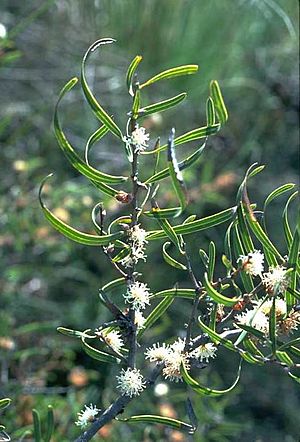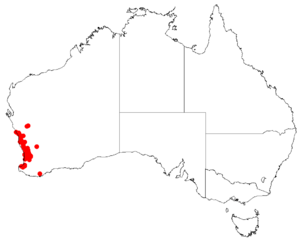Hakea stenocarpa facts for kids
Quick facts for kids Narrow-fruited hakea |
|
|---|---|
 |
|
| Hakea stenocarpa in the ANBG | |
| Scientific classification | |
| Genus: |
Hakea
|
| Species: |
stenocarpa
|
 |
|
| Occurrence data from Australasian Virtual Herbarium | |
The Narrow-fruited Hakea (scientific name: Hakea stenocarpa) is a type of shrub. It belongs to the plant family called Proteaceae. This plant is special because it only grows in certain parts of Western Australia. You can find it in the Mid West, western Wheatbelt, Peel, and South West regions.
This hakea has lovely creamy-white flowers that smell sweet. Its leaves often curl in a cool way.
What it Looks Like
The Narrow-fruited Hakea is a small, round shrub. It usually grows to be about 0.3 to 1 meter (1 to 3 feet) tall. It has many stems and can regrow from a special woody base called a lignotuber if there's a fire.
When it flowers, its small branches are smooth. The plant produces groups of 14 to 20 sweet-smelling flowers. These flowers are white, creamy-white, or yellow. They grow where the leaves meet the stems on the upper branches.
The flower stalks are smooth and cream-white. The flower parts (called the perianth) are also cream-white. The part of the flower that receives pollen (the pistil) is about 4.4 to 5 millimeters long.
The leaves of this hakea are long and thin. They are usually 6 to 11 centimeters (2.4 to 4.3 inches) long and 2 to 7 millimeters (0.08 to 0.28 inches) wide. Each leaf has a clear, pale yellow line down the middle. A cool thing about these leaves is that they often curl upwards in a spiral shape.
Unlike many other hakea plants, the fruit of the Narrow-fruited Hakea is long and narrow. It's shaped like an oval and is about 2.8 to 3 centimeters long and 0.6 to 0.8 centimeters wide. The fruit tapers to a pointed tip, like a beak. The surface of the fruit is rough and bumpy where it connects to the branches.
Naming the Plant
The Narrow-fruited Hakea was first officially described in 1830. A botanist named Robert Brown gave it its scientific name, Hakea stenocarpa. He published his description in a book called Supplementum primum prodromi florae Novae Hollandiae.
The name stenocarpa comes from two ancient Greek words. "Stenos" (στενός) means "narrow," and "karpos" (καρπός) means "fruit." So, the name "narrow-fruited" perfectly describes the shape of its fruit!
Where it Grows and Lives
The Narrow-fruited Hakea likes to grow in different types of natural areas. You can find it in:
- Heath: Areas with small shrubs.
- Low open shrubland: Places with low, spread-out bushes.
- Woodland: Areas with trees and other plants.
It grows well in deep sand, loam (a mix of sand, silt, and clay), clay, and gravel. Sometimes, it grows over a type of soil called laterite. This plant needs a spot where the water drains away easily. It also likes to be in the sun or in a place with some shade.
Because it's a pretty shrub, people sometimes plant it in gardens. It can even be used as a plant that spreads out and covers the ground.
How it's Protected
The good news is that the Narrow-fruited Hakea is not considered to be in danger. The Western Australian Government's Department of Parks and Wildlife has classified it as "not threatened." This means there are enough of these plants in the wild for now.

